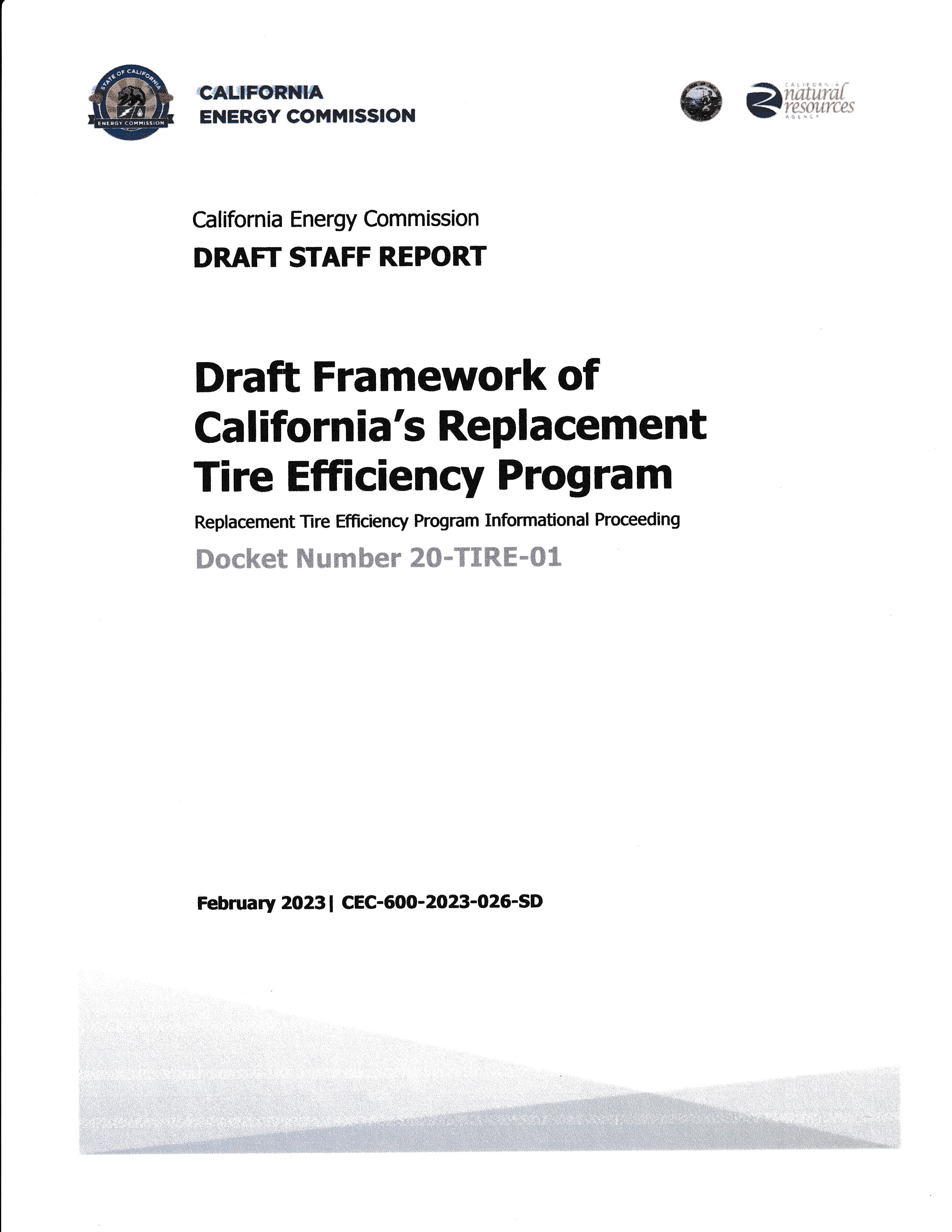
|
B
arry's
T
ire
Tech This is a series of articles on the technical aspects of tires, their care and usage. My primary purpose in these articles is to help people understand tires and thereby reduce the risks we all face every day. ..........and since tires is just about the only thing I know about.......... Please drop me a note if you have a topic you want to see: Barry@BarrysTireTech.com |
|
This is a commentary on the California Energy Commission's proposal for new regulations on tire rolling resistance.
Here's a link to that proposal: Feb 2nd Draft This draft was published on Feb 2, 2023 and supersedes the one published on Feb 1, 2023. I don't know why they published a new draft, nor what differences there might be. Update: Jan, 2024: On 23 May, 2023, USTMA applied for a confidentiality agreement for a file of data they wanted to give the CEC. That file has over 7400 lines of data. They did not specify what was in the file, but they did say that their members would only agree if they got confidentiality. They specifically said that this data wasn't even shared with their members, which I interpreted to mean that this was the kind of data that any tire manufacturer would like to have. What is the data? Best guess: RR data and all the other data CEC proposed to publish in their TRRED database. As a tire engineer, I know that I would be interested in this data - even if the tire manufacturer wasn't identified. So I apologize to my readers for not publishing an update until now, but I thought the CEC would look at the data, do an analysis, and publish a summary - but that has not happened. I suspect that what is going to happen is that the CEC will go back to the California legislature and tell them that they can not implement the legislation as written. That if they want some sort of regulation on rolling resistance of tires, they have to rewrite it.
I'll publish an update if they do. Update: Feb. 16, 2023: OK, this isn't really an update since I haven't published this page yet, but I wanted to include the results of the Feb. 14, 2023 workshop where the CEC formally introduced the proposal and solicited comments. I've outlined below some of the details about the proposal, so this section is about the feedback the CEC received at the meeting. A lawyer representing small independent tire dealers (and other similar businesses) asked about who would be enforcing those regulations. The concern is that an independent tire dealer is not equipped to determine whether or not a tire meets the proposed regulations. He pointed out the situation where a tire dealer is confronted with a new set of tires obviously shipped in from sources out of state, and he wondered how the CEC was going to address that situation. A representative from the USTMA (US Tire Manufacturers Association) gave a presentation where they suggested the following:
|
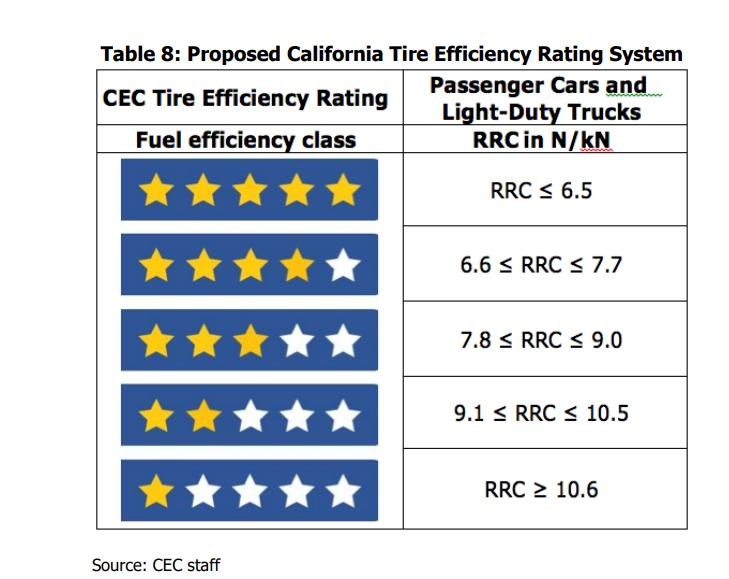
|
What is proposed: On January 1, 2026, all replacement tires for cars and light duty trucks (less than 10,000# GVW) sold in California will meet an RRC (Rolling Resistance Coefficient) of 9.0 N/kN or lower. On January 1, 2028, the RRC value must be 7.0 or lower. Note: N/kN = Newtons per kiloNewton - a Newton is the metric unit for force, analogous to Pounds). The proposal excludes snow tires, motorcycle tires, and limited production tires (less than 15,000 produced in a year). However, it appears that the proposal also covers LT tires, but that isn't specifically called out. (Side Note: LT tires generally have better RRC values than P type tire. That's important further down.) All tire manufacturers or importers will conduct their own testing, but that the data will go into a publicly accessible database called the Tire Rolling Resistance Efficiency Database (TRRED). Among the data will be Rolling Resistance Coefficient (RRC), the UQTG Traction value (this is a sliding value), the peak traction value obtained from that same test, and the MSRP (Manufacturer's Suggested Retail Price). To the right is the proposed grading system. It is the same as the European Union's, except this uses stars. The proposal also added a requirement for a grading system for peak traction that was similar to what the European Union uses. I did not present this table here, but it is in the proposal. The proposal does not require labels or tire markings - only point of sale display. The proposal seems to imply that it would be OK if tire manufacturers estimated values provided "due care" is taken. (If I heard this correctly during the Feb 14, 2023 workshop, this is correct.) |
|
The test is ISO 28580, which is a single point test, and measures the RR of a tire at 80% of its rated load and at its rated pressure. The result is a force value (RRF), but it is common to use RRC (Rolling Resistance Coefficient = RRF divided by the test load). |

|
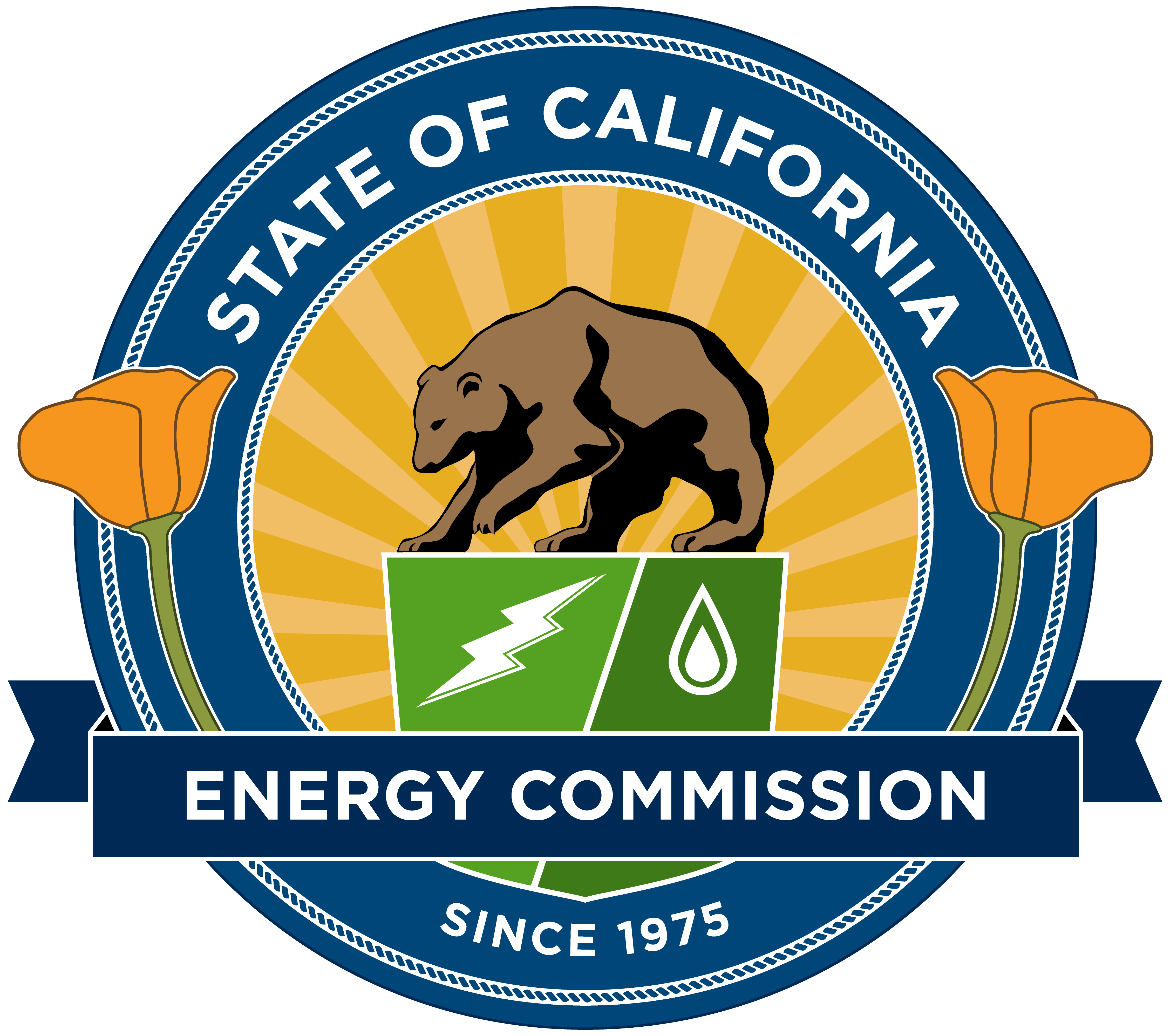
|
Background: In 2003, the California legislature passed Assembly Bill 844, which directed the commission to start a program - and I'll quote from the Draft:
The original timetable called for implementation by 2008. This did not happen. I suspect the delay was because of the HUGE!! Firestone recall in August 2000 that spilled over to affect every tire manufacturer. Plus, the timeline was optimistic even without that. |
|
In December 2007, the CEC reviewed some test data generated by Smithers Scientific Services at their request. Smithers is a test organization, well respected by the tire industry. They were the perfect group to conduct such tests. Here's a link to the presentation: http://www.energy.ca.gov/......Testing.pdf In 2009, NHTSA (National Highway and Traffic Safety Administration - a branch of the US Federal government) announced they were going to issue a Federal Rule for Rolling Resistance of tires. The CEC decided to postpone their work to see what NHTSA was going to do. In 2010, NHSTA published a proposed rule and the tire manufacturers objected (and in my opinion, rightly so.) The rule was withdrawn and NHTSA has repeatedly postponed the issuing of a revised rule. So in Nov 2020, the CEC reactivated their project and the result is this proposal. There was a workshop on Feb 14, 2023, where the proposal was introduced. Also, the USTMA (US Tire Manufacturers Association) presented their comments. |
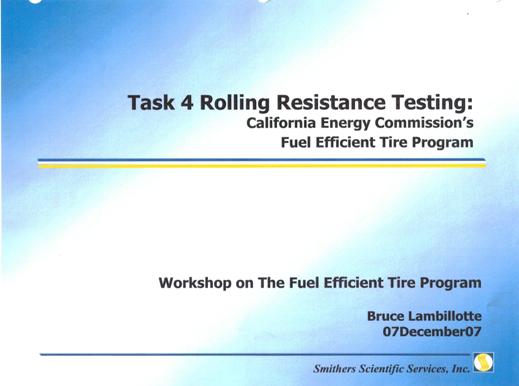
|

|
Critique: It starts with AB844, the document that prompted this program. The bill calls for setting a minimum standard for replacement tires of equaling OEM levels. Not only is that a moving target (maybe intentionally), but the target was the average of OE Tires. It appears that the CEC is interpreting that the average is supposed to be the limit (based on the data supplied by Smithers) and that means that some OE tires could not be sold in California, I hope I don't have to explain why that is a bad idea. The bill also appears to be written with the false premise that there will be little, if any, negative consequences, or that the bad will be balanced out by the good. That is clearly false. OE tires have a deserved reputation of having wear and grip problems. And this might mean that the market in California would still contain those undesirable tires - maybe even more of them! Yes, I am aware that this program looked at the UTQG ratings of tires and concluded the proposal would not cause a safety issue, but things are more complex than that. The UTQG test is conducted on a pair of surfaces, but not every road surface is like those 2 surfaces. Some road surfaces generate quite poor traction FOR SOME TIRES, and tire manufacturers try to avoid this - and the result is tires that have higher RR. |
|
The proposal itself:
I have no beef about a new system to inform consumers the fuel consumption impact their tire purchase has. In fact, I encourage this. What I have a concern about is the aggressive nature of the restriction - to wit: They intend to ban the sale of both 1 star and 2 star tires, making no provision for the fact that RRC varies considerably by size, and by tire type. For example: An All Terrain tire will have considerably more RR than the same sized highway tire - both because the ALL Terrain tire has much more tread rubber, but also because a tread rubber compound suitable for some off road usage is naturally going to be worse than the tread rubber suitable for highway use. The USTMA estimated that 76% of current replacement market tires would not be allowed to be sold in California. |

|

|
Further, in 2028, they would ban the sale of some OE tires - and that just doesn't make sense. I don't think that was what was intended by the legislature. Admittedly, the legislature should revise the wording of AB844 to reflect their true intent. The USTMA estimated that 99% of replacement tires would not be allowed to be sold. |
|
Solutions? The USTMA proposed that the RRC value limit be 10.5 N/kN - and that includes a buffer of 0.5 so tire manufacturers would be sure to be in compliance. They also proposed including winter tires at 11.5 N/kN. They did this because they wanted a North American standard and Canada's market is more than half winter tires! They also suggested that Competition tires be excluded (Note: Some racing organizations require tires to meet DOT requirements, hence the request.) as well as excluding LT and C type tires as those are primarily used on commercial vehicles AND tires higher than a V speed rating (That means W, Y, and Z) I'll include a copy of the USTMA's presentation when it becomes available Here! |
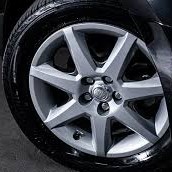
|
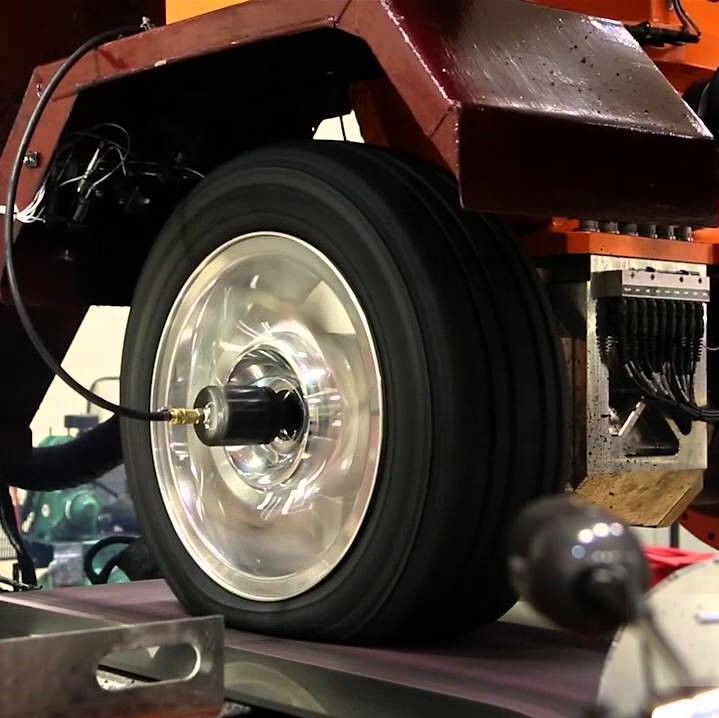
|
My Proposal; Since I really dislike it when someone complains and doesn't offer a solution, here's mine. On a earlier webpage on Rolling Resistance - Here!, I calculated a formula for RRC vs tire size. I am sure the tire manufacturers could do a better job of this than I did, after all, they not only have an incentive to do so, but they also have lots more data. This is important because the range of RRC values in a line of tires with many sizes can vary as much as 25% - meaning that the worst tire in a tire line might not meet the minimum, while the best could. Example for a full line of tires to meet 7.0 RRC, the best tire must be 5.6 RRC.
|
|
I would propose that ALL tires be referenced to the SRTT (Standard Reference Test Tire) by using that formula to create a size equivalency formula and that the limit for RRC be 3 sigma of the RRC equivalent of the OE tires for a given category of tire for a given time period (which appears to be 3 years). Further that there be different categories of tires, such as All Terrain, High Performance, and All Season - AND that P type tires and LT type tire be calculated separately. That is there would be a standard for P type All Terrain tires based on P type All Terrain OE tires - and that would be different than the standard for P type High Performance tires (which would be compared to OE P type High Performance tires) - and all those standards would be based as though the individual tires were the same size as the SRTT. Yes, that is complicated, but I am sure anyone with a bit of technical background could handle the math. Certainly, someone at Smither's could. Besides, the consumer would only see the rating of the tire, not the math. As a starting point, I can see eliminating 1 star tires until the database is populated with at least a year's worth of data. And here's a copy of Smither's summary of testing for this program. |
|
|